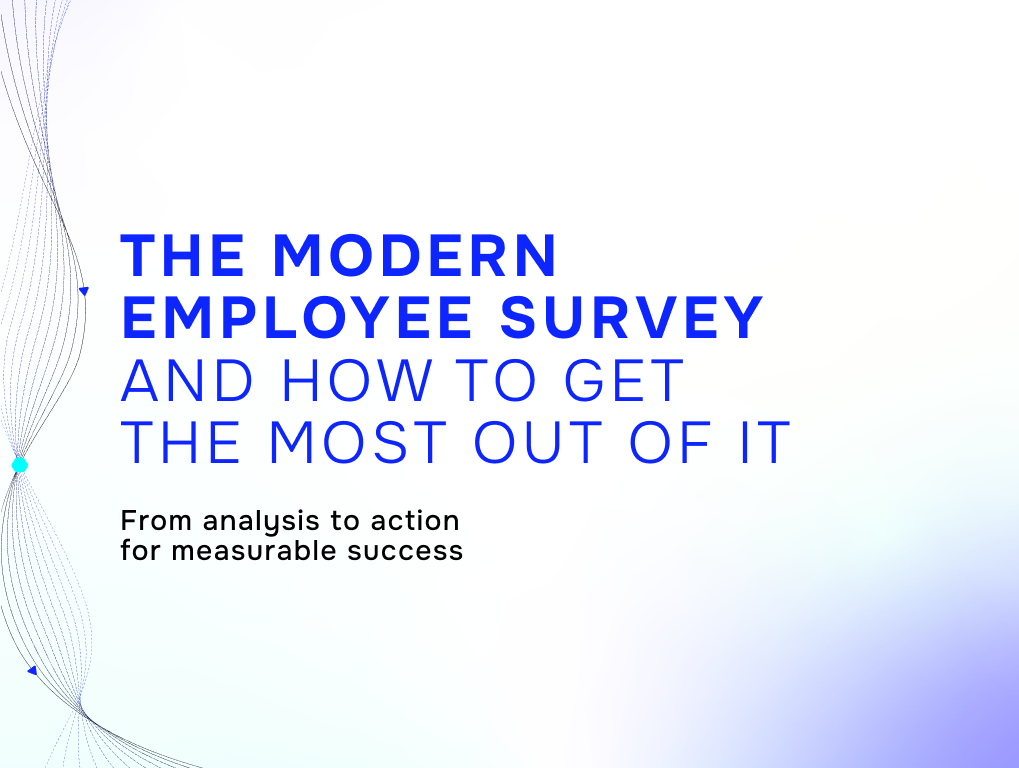Feedback is an essential aspect of any workplace. Throughout this post we will review what aspects are basic to say that an organization has a culture open to feedback and with a simple test you will know if yours is one of them.
An environment that fosters effective feedback is established when employees, regardless of their position and responsibilities, feel empowered to share their thoughts and opinions about their work and the overall functioning of the organization.
Constructive feedback can help employees grow and improve, while also providing managers with valuable insight into how their team is performing.
However, feedback can also be a source of stress, particularly if it’s not delivered effectively. This is why it’s essential to create a positive feedback culture in your workplace.
By building a culture of open communication, creating a feedback-friendly environment, and encouraging employees to give feedback, you can turn criticism into collaboration and drive growth and improvement.

The human side of enterprise
The concept of a “culture of feedback” in organizations has been discussed by multiple authors over time. However, one of the earliest and most influential authors to discuss this concept was Douglas McGregor, a management professor at the MIT Sloan School of Management.
In his 1960 book “The Human side of enterprise,” McGregor introduced the idea of Theory Y, which posited that employees are inherently motivated and can be trusted to take responsibility for their work if given the right environment and support. One of the key elements of this environment, according to McGregor, was a culture of feedback, where employees receive regular and constructive feedback on their performance.
McGregor argued that this type of feedback was essential for employees to grow and develop in their roles, and that it was the responsibility of managers to create a culture that supported this type of feedback. His ideas on Theory Y and the importance of a culture of feedback have had a lasting impact on the field of management and organizational behavior.
A 7-question test to find out if your organization has a feedback culture
Is your organization a company with a feedback culture? Guess it by answering these 7 basic questions.
- Is feedback used to inform performance goals and development plans?
- Do managers and employees engage in two-way feedback conversations?
- Are employees recognized for incorporating feedback into their work?
- Does your organization have a customized year-round employee listening strategy and the technology to implement it?
- In the case of having defined feedback collection and analysis processes, does the organization implement improvement actions (and tracking) after feedback analysis?
- Are the results of the feedback collection shared with employees?
- Does your organization regularly collect feedback from employees on their experience with the feedback process?
If you have answered “Yes” to 5 or more of the 7 questions then congratulations! your organization has a feedback culture in place.
If not, there is clearly work to be done, but it is always a good time to start. Read on to learn about the keys to a feedback culture.
Building a culture of open communication
One of the most critical factors in creating a positive feedback culture is building open communication. This means creating an environment where employees feel comfortable sharing their thoughts and ideas, and where managers are approachable and open to feedback. This can be achieved in several ways.
#1 Receiving feedback as a manager
Firstly, it’s essential to lead by example. If managers are open and honest in their communication, employees are more likely to follow suit. This means being transparent about company goals and objectives, as well as being willing to admit when things are not going well.
As a manager, it’s essential to be open to feedback yourself. Create an environment where employees feel comfortable giving feedback to their managers, and where managers are willing to listen and act on feedback. There are several ways to achieve this.
- Be approachable. It means being open to feedback, actively seeking out feedback, and responding positively to feedback. You can create an environment where employees feel comfortable giving feedback.
- Actively solicit feedback. Asking for feedback regularly, and providing opportunities for employees to share their thoughts and ideas. You can ensure that you are receiving feedback regularly and that you are addressing any issues that are raised.
- Act on feedback. Taking the time to carefully consider feedback, and then taking action to address any issues that are raised. By acting on feedback, you can demonstrate to your employees that you take their feedback seriously and that you are committed to addressing any issues that are raised.
#2 Encourage collaboration
Another way to build a culture of open communication is to encourage collaboration. When employees work together on projects, they are more likely to share their ideas and feedback.
This can be achieved through team-building exercises, cross-functional projects, and regular team meetings.
#3 Channels of communication
It’s essential to establish clear channels of communication. It is important to provide employees with multiple ways to share their feedback, including in-person meetings and online employee surveys, for example.
By creating a variety of channels, employees are more likely to feel comfortable sharing their thoughts and ideas.

Creating a feedback-friendly environment
In addition to building a culture of open communication, it’s essential to create a feedback-friendly environment. We are talking about an atmosphere where feedback is expected, welcomed, and valued.
#1 Ways to achieve:
- Establish clear guidelines around feedback. Setting expectations around the frequency and type of feedback that is expected, as well as providing training on how to deliver feedback effectively. By setting clear guidelines, employees are more likely to feel comfortable giving and receiving feedback.
- Provide regular opportunities for feedback. It can be achieved through regular performance reviews, as well as through more informal check-ins and online surveys for employees.
- Celebrate feedback. This means acknowledging when employees provide feedback that leads to positive outcomes, as well as recognizing employees who are particularly skilled at giving and receiving feedback.
#2 Psychological safety
Organizations now recognize the benefits of creating a psychologically safe workplace for their employees. Psychological safety is fundamentally based on the principle of equality and respect towards all individuals, irrespective of their role or designation.
Its essence lies in fostering a workplace environment that instills trust and provides a platform for individuals to take calculated risks, explore their creativity and express their opinions without the fear of facing adverse consequences.
Such an atmosphere plays a crucial role in promoting a conducive work environment that is marked by a culture of cooperation, teamwork and fresh ideas.
There are 4 stages about psychological safety in the workplace.
Stage 1: Safety of Inclusion pertains to the fundamental human desire to connect and belong to a community where you feel secure enough to express yourself freely, and your strengths are embraced and valued.
Stage 2: Safety of Learning involves actively participating in group discussions, asking questions, and providing feedback to others, thereby fulfilling the need for personal growth and intellectual stimulation while developing the ability to think critically on the spot.
Employee listening strategy: is it worth it?
Encouraging employees to give feedback is another critical aspect of building a positive feedback culture. This means creating an environment where employees feel comfortable sharing their thoughts and ideas, and where they understand the value of feedback.
The best way to encourage employees to give feedback is implementing a personalized employee listening strategy in the organization. It helps companies meet the specific needs of their workforce while also creating a sense of inclusion among staff members.
A personalized listening strategy can bring a range of benefits to organizations. Firstly, it helps to foster a sense of belonging and engagement among employees. When individuals feel that their opinions matter and are heard, they are more likely to be invested in the success of the organization.
Additionally, a personalized approach allows for targeted feedback collection which can lead to specific improvements within different departments or teams. This strategy provides an opportunity for management to gain insights into employee needs and preferences related to work conditions, training opportunities, career advancement options and other areas.
Moreover, implementing this type of strategy demonstrates an organizational commitment towards employee well-being which can help with retention rates as well as attracting new talent. By showing that the organization values its employees’ opinions and feedback enough to create a unique listening approach just for them, employees may develop greater loyalty towards the company.
A personalized listening strategy is beneficial not only in terms of improving communication but also enhancing overall job satisfaction levels among employees resulting in increased productivity.
#1 Powerful figures
Large companies such as Google, Microsoft, Amazon and Netflix have implemented a feedback culture and it must be because it is generating great results. Don´t you think so?
Several studies show the great advantages.
- Productivity: A study by Harvard Business Review found that organizations that encourage regular feedback have 14.9% higher employee productivity compared to those that don’t prioritize feedback.
- Innovation: A survey conducted by McKinsey found that companies with a strong culture of feedback were twice as likely to innovate effectively compared to those without a feedback culture.
- Customer Satisfaction: According to a study by Deloitte, companies that prioritize feedback have 3.6 times higher levels of customer satisfaction than those that don’t.
#2 Online employee surveys
The use of online surveys allows us to implement an active employee listening strategy in a simple way. Online surveys are a popular tool used by organizations to collect employee feedback. They offer several benefits, including:
- Convenience: They are easy to create and distribute, and employees can complete them at their own convenience, without the need for in-person meetings or interviews.
- Anonymity: It allows employees to provide feedback anonymously, which can encourage more honest and candid responses.
- Data Analysis: Online surveys provide data that can be easily analyzed and interpreted, allowing organizations to identify trends and areas for improvement.
- Cost-effective: They can be less expensive than traditional methods of collecting employee feedback, such as focus groups or interviews.
- Timely: Online surveys can be distributed and completed quickly, providing timely feedback to organizations.

#3 The role of technology in employee feedback
Feedback methods should be continually improved over time. For any HR manager, selecting the appropriate survey tool is crucial.
In case you want to implement online surveys for employees, it is very useful to have a provider specialized in collecting and analyzing employee feedback. A platform that allows to collect, analyze and easily detect the areas where improvement actions need to be implemented. And, of course, tracking the impact of the generated actions.
Opting for a platform like the atwork Suite, which includes an AI-recommendation and action plan feature based on survey results, can be highly beneficial. The platform’s AI capability can detect trends within the data, allowing you to identify areas that require improvement and establish practical plans to address them. This is a significant advantage that traditional survey methods are unable to provide.
#4 An effective methodology
A clear methodology – such as atwork’s Measure, Act and Impact – makes it easy to establish an employee listening strategy.
- Measure: The first step is to collect and measure employee feedback. The goal is to gather as much feedback as possible from employees to understand their experiences with the organization, leaders, colleagues, development and job role.
- Act: Once employee feedback has been gathered, the next step is to act on it. This involves reviewing and analyzing the feedback to identify areas for improvement and develop an action plan. The action plan should be tailored to address the specific concerns and needs of the employees and may include, for example, changes to policies, procedures, or management practices.
- Impact: The final step is to measure the impact of the actions taken based on the employee feedback. This involves gathering feedback again to see if the changes have been made. It is important to track progress over time and make adjustments as needed to ensure continuous improvement.
Some final thoughts
A feedback culture in organizations clearly transforms criticism into collaboration, which allows the organization to grow and prosper.
The best way to ensure that you have a feedback culture is to create a culture that values feedback. This means consistently engaging employees in constructive conversations about their work, creating a culture of trust, and ensuring that all employees feel empowered to give and receive feedback.
HR managers have a unique opportunity to support growth and improvement. Organizations that value feedback are more likely to receive support from their employees and keep them motivated, which ultimately leads to an increase in output and stability.
So why not start implementing a feedback culture today and see the positive effect it may have on your organization?



